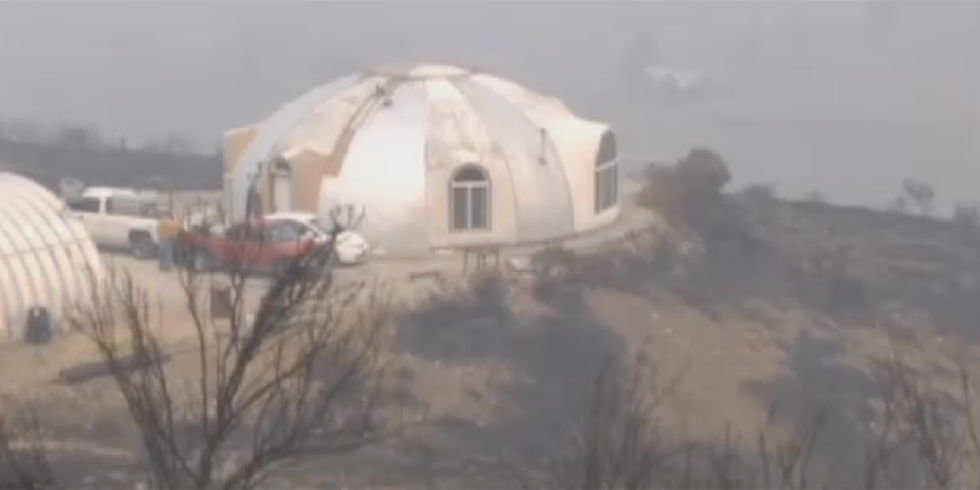
Those that are rebuilding after tornado or hurricane should also consider a dome home. The curved surface provides a significantly reduced area that high winds are able to push against.
I’m not sure preparing and waiting for another fire is the best answer. I lived in the state from birth to adulthood in the central valley, and we had to handle our share of fires in the Sierras and coastal mountains. And the one thing obvious to the returning of the problem is the ground vegetation.
If the trees burn and are gone, and won’t be back for many years, why do the fires happen every year? Simple, the only fuel available is ground vegetation to include new growth trees. It has time to sprout and grow to do so. So if it is not controlled or removed, then after it goes the only thing left is rebuilt buildings which is our problem, not the forests’. This is how natural back burning accomplishes growth and has for thousands of years until man put up other fuel.
Therefore, since man has to change something in their land takeover, but fails to do so, they continue to be toast. The state or the feds need to control growth if they are going to invade an area. And that means controlled burns and brush clearing which they won’t do because of the ecologists. And they have no idea, or don’t care, what needs to be done to correct their spotted owl or any other problem. They need to weigh in on what’s important.
rwood
#1: Don’t forget that next year’s insurance policy changes might be huge or a complete cancelation.
Once a fire has burned the excess fuel, the area is safe for at least a dozen years.
Or they could think about forestry management.
You have provided good advice. I would add that people need to do a lot of research to find someone who is not a fly by night scam artist when finding a contractor that does this type of work.
I think that your first sentence could be easily misconstrued. While it may be appropriate depending on location and soil conditions to have the floor of your shelter 20 feet down... in most cases it would add a massive amount of unnecessary expense and complications to try and get the top of your shelter 20 feet down... for very little gain.
There are many books and articles available on this subject. Unfortunately a lot of them were written by people with less than stellar credentials.
ONLY a couple of hundred thousand dollars added to your rebuild???
Has this person ever been outside of his high end gated community?
The valley I live in has not got one single house that cost a couple of hundred thousand to build-—ever.

“First, put in an underground fire shelter about 20 feet down”
No need for 20 feet. A simple shelter just a few feet under will work just fine. Just get past the root layers where fires burns underground. Probably 4-6 feet in most areas.
Many fire bunkers can cost less than $20k, and some I’ve seen are about $10k, installed.
We don’t have a fire shelter because we have 5 different roads out of here and can vacate quickly.
Uh,don’t..?
What would an underground fire shelter do for an oxygen supply? Just curious.
First of all, what will keep the generator from burning?
Second, there’s a chance that when the fire goes over the oxygen could be sucked out through the air vent.
Not to take issue with your idea, putting a structure underground sounds like a good idea but what about the fresh air needed to live underground? If you’re in the middle of a fire wouldn’t you have to deal with super-heated air? What about smoke? Either would be detrimental to both the inhabitant and also the successful running of any type of power-generating equipment.
Fireproof shelter 20 feet under won’t do much good unless also have an air lock with adequate O2 and CO2 scubber supplies. Otherwise they’ll merely represent self-entombment.
1. I was a volunteer firefighter years ago. 80s and 90s.
2. Separation distance is a key factor, since much of the heat transfer is from radiation and convention, versus conduction or direct flame impingement. Net: require bigger buffers between structure, and between structures and natural combustibles.
2.1 require or choose exterior materials that have higher ignition temps and conduct less heat. I have seen reports where houses actually caught fire first on the inside, like curtains or wooden walls, etc from radiant heat. Consider Florida style hurricane shutters or roll-up windows and bear-proof Alaska doors. Add fire resistant window treatments on exterior windows.
3. Consider requiring or choosing poured or block concrete walls and the use of metal framing and sheathing for roof structures.
4. Lastly why does no one use exterior fire sprinkler/suppression systems? These emit high volume spray/mist mostly to suppress the temperature of structural combustibles and reduce radiant heat impact. Think of your house as a potential BLEVE, and how you might prosecute that event.
Fire-Resistant Details
Studying the houses that survived the 1993 Laguna Beach fire storm yields lessons in building to withstand the heat
By John Underwood
June 1, 1995
Fine Homebuilding Magazine
It seems few houses are built with the proven fire-resistant details that have been known for thirty or more years. Sole surviving houses do not happen by accident...
Concrete roof with no less than a 10,000 gallon water tank with sprinklers.
And if nothing else an earth covered carport.
Curious: from whence does an underground fire shelter get its fresh air? As none is available in a fire of these sizes, even hundreds of feet up from the ground..........
My advice: DON’T!
Take your insurance money and get out!